Trail Restoration Project
Los Glaciares National Park Argentina
An American Alpine Club project
Supported by a generous grant from Patagonia Inc.
First work cycle report
Trail work October to December 2008
Revegetation work February and April 2009
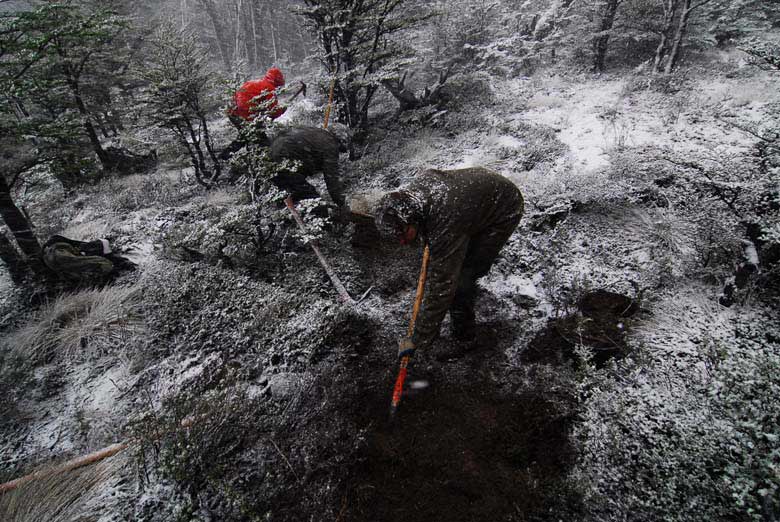
The following report was written by the project coordinator Rolando Garibotti.
Focus.
In the seven weeks of work in 2008, and in three weeks in early 2009, the project was focused on the restoration of the most heavily eroded trail in the northern area of Los Glaciares National Park, the Rio Blanco Camp to Laguna de los Tres trail, which is an old climbers trail, used to access the East side of Cerro Fitz Roy and Aguja Poincenot. Today, this is one of the most visited trails in the area, and sometimes sees several hundred hikers in a single day. The APN had identified this trail as a problem area long ago, and local rangers had already taken steps and done some work to remedy some of the issues.
The erosion problems of this trail stem from the fact that the trail climbs 1500 feet of elevation gain up a very steep slope without hardly any switch backs. After studying the problem with Brian Bergsma, Trail Supervisor for Grand Teton National Park (GTNP) in March 2008 it was decided to work on restoring the existing trail. No viable alternatives for a new trail were found and even if one alternative had been found, it was deemed impossible to recover and revegetate the existing trail.
The work was divided in two cycles. From October to December we worked on trail building and maintenance, building a number of erosion prevention “structures”, while in February and April work was done to revegetate the areas surrounding those new “structures”. The report is therefore divided in two sections.
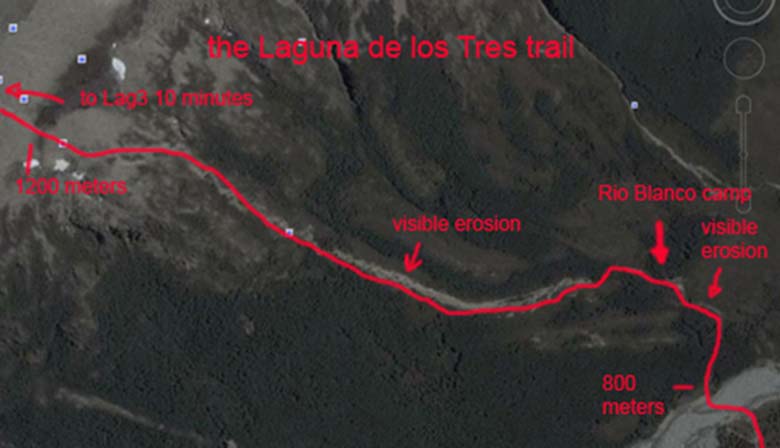
Above: An aerial view of the Laguna de los Tres trail, which gains 400 meters of elevation gain between the Rio Blanco riverbed and Laguna de los Tres.
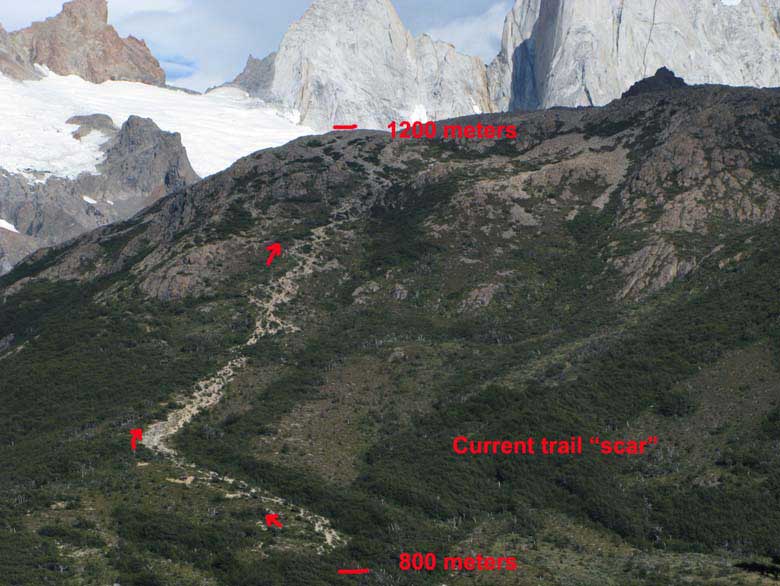
Above: the most heavily eroded section of trail in the northern section of Los Glaciares National Park. It is so eroded that the scar can be seen from miles away.
Trail work
Personnel.
The 2008 team was assembled combining five trail experts, all of whom work during the summer months in Grand Teton National Park, five Argentine climbers, guides and outdoorsmen, all of whom have lived and spent much time in and around Chalten for a number of years and one biologist specialized in high altitude ecosystems, as well as a number of other volunteers that came to help from time to time.
• Jorge Ackermann, 22, Argentine, ski instructor, climber and carpenter.
• Tomas Aguilo, 23, Argentine, climber and guide.
• James Bouknight, 34, American, NPS trail crew leader, journalism major.
• Rolando Garibotti, 38.
• Nick Gillespie, American, 25, NPS trail laborer, firefighter, surfer, climber and singer-songwriter aficionado.
• Cullen Kirk, American, 24, NPS trail laborer, climber and photography aficionado.
• Leonardo Martinez, 37, Argentine, PE teacher, gaucho aficionado, outdoorsman.
• Juan Jose Landucci, 26, Argentine, Argentine National Parks employee, Tourism major, our “Mate” specialist.
• Mark Loseth, 26, American, NPS trail crew leader and climber.
• Max Ludington, 27, American, NPS trail crew leader, skier, mandolin aficionado, radio host and librarian.
• Matias Villavicencio, 31, Argentine, climber and guide.
Several other volunteers came up to help, specially Marcos Mendoza, as well as Aristides, Dante, Doerte, Gerardo, Lucas, Mercedes, etc.
Plan. A camp was set up in Rio Blanco, including a number of tents kindly donated by MSR. We worked on a “four-days-on” and “two-days-off” schedule, hiking up early in the morning of the first work day, and down on the evening of the last work day of each cycle. This allowed us to spend only 3 nights per work “week” up at the camp, somewhat minimizing our impact. The remaining nights were spent in a private campground in El Chalten, Albergue Lago del Desierto where Toni, the manager, was kind of enough to cut us a good deal. The 4 to 2 schedule worked well considering the constant rain and wind. Initially a longer work week was considered, but it became apparent that working more than 4 days in a row under those conditions was too tiring.
In two trips we were able to hike up all the tools required, including a rock bar, shovel, hammer and polasky per person, plus chainsaw, several matoxs, chisels and other. Once the tools and camping gear were up, we hiked back and forth from town (2 hours aprox) with minimal gear. The tents were left set up in the Rio Blanco camp for the duration of the work.
Trail restoration results:
The original intent for the 2008 cycle was to work exclusively on the trail leading from the Rio Blanco camp to Laguna de los Tres –this trail is almost entirely above tree line-, but the reigning bad weather forced us to work close to 40% of our time inside the forest, in the section immediately below the Rio Blanco camp, where the protection afforded by the trees allowed us to work under almost any weather conditions. While this put a dent on the amount of work we accomplished in our primary objective, all the work done below Rio Blanco, including more than 30 steps, 60 feet of causeway, 150 yards of re-route, a bridge and other, were badly needed to ensure the sustainability of those sections of trail.
In the next work cycle starting in October 2009 we hope to continue working on the Laguna de los Tres trail, therefore we will have to find projects of similar character – eroded sections of trail inside tree line- to have as fall back when the weather does not allow work higher up. There are a number of alternatives, including work on the Poincenot Camp itself, which is heavily eroded. This will be discussed with the APN.
In the 2,200 man/hours of work that we put in between late October and early December 2008 and to prevent further erosion and ensure sustainability of the trails we built the following “structures”
• 47 wood steps
• 225 rock steps
• 11 square meters of retaining wall
• 84 drains
• 28 feet of bridge
• 27 rock water bars
• 45 feet of causeway
• 13 wood water bars
• 7 checks
• 350 meters of "new" trail.
With authorization from Carlos Zoratti we rerouted the trail in two sections that were heavily eroded. The eroded areas were “prepped” for a speedier natural recovery.
The photo below shows some the sections of trail where the work was focused, and the kind of work that was done in each section.
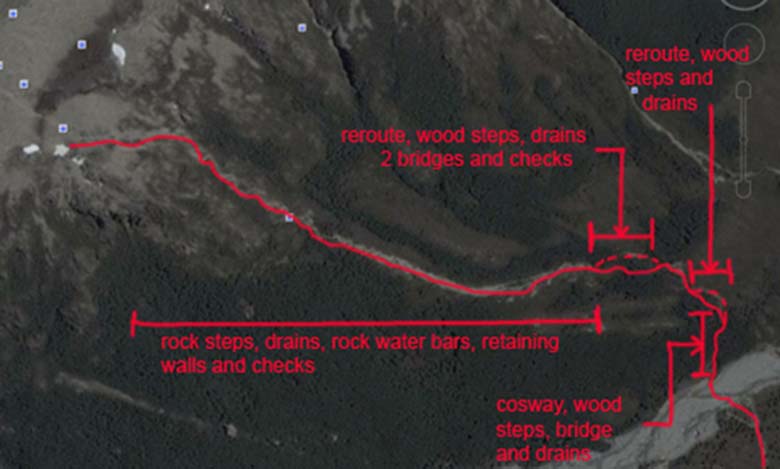
Estimated Cost:
The estimated cost of the work done, had it been done in the US and using US trail laborer wages according to the degrees of expertise of each, would have been well over $60,000 -includes tools and some minimal expenses, but does not include insurance, travel, lodging and other costs. In all 2,200 man-hours were put in between late October and December 2008.
It should be noted that it took more than year of planning before the project got underway. During that period Garibotti, the project coordinator worked closed to 400 hours, studying a number of alternatives (including a two week long evaluation trip to the area), securing the necessary permits, buying tools, insurance and other.
Some examples of the results:
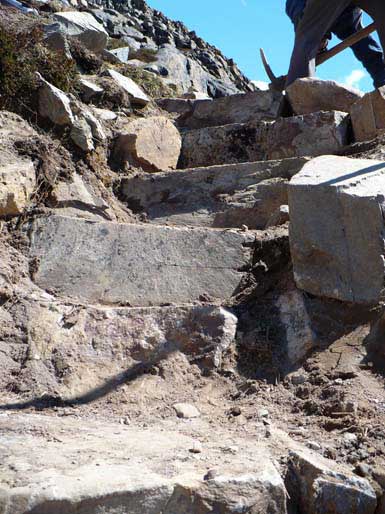 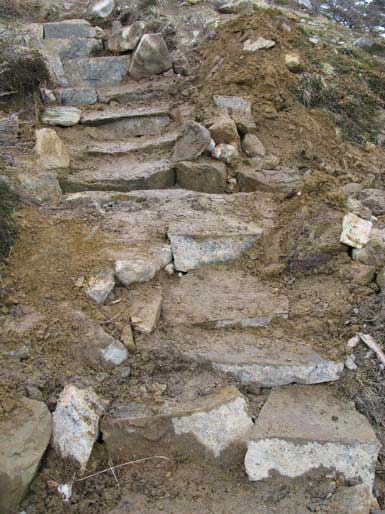
Rock steps and drains in the Laguna de los Tres trail.
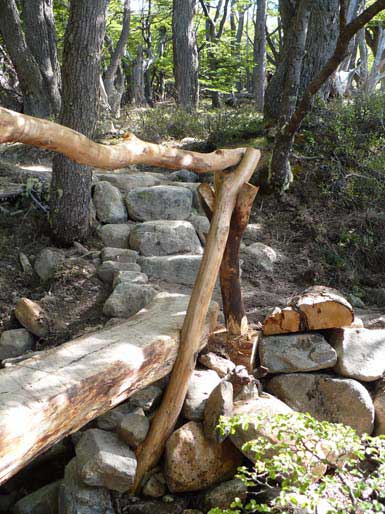 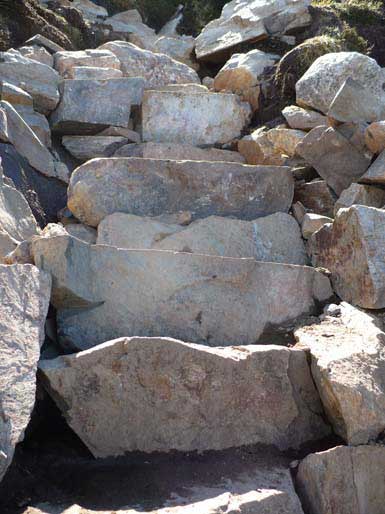
Above left: rock steps in the Laguna de los Tres trail.
Above right: a new bridge and steps in a 200 yard reroute above the Rio Blanco camp.
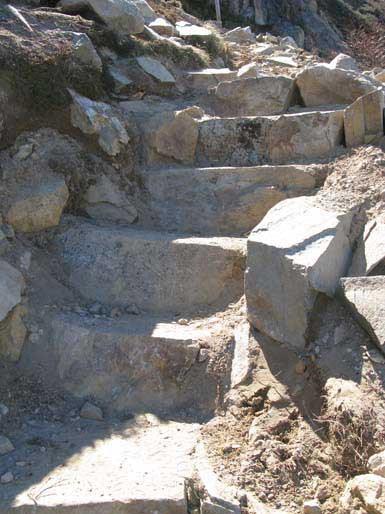 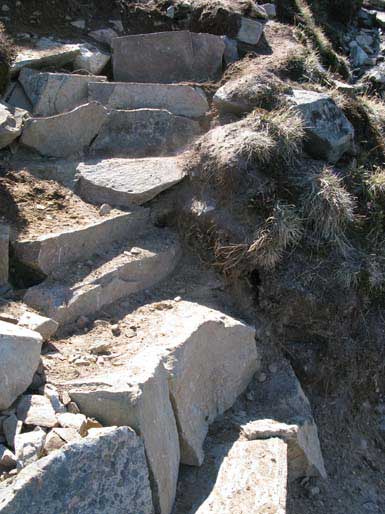
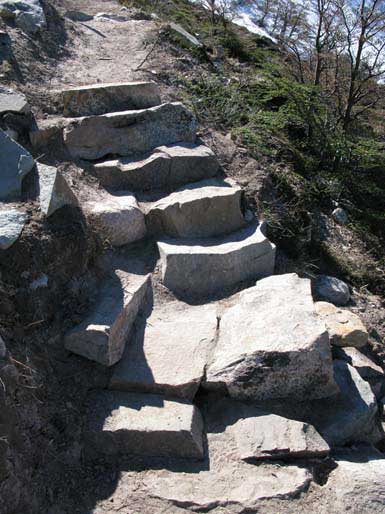 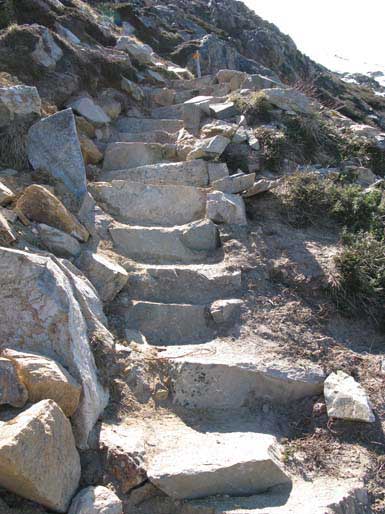
Above (all four): Rock steps in the Laguna de los Tres trail.
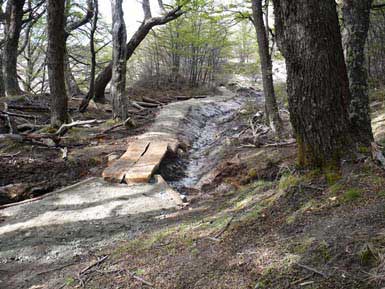 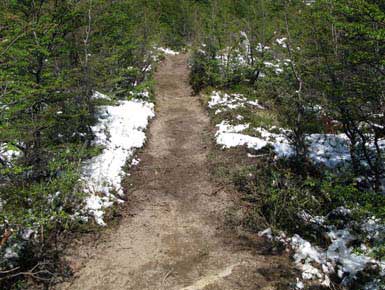
Above left: a section of the reroute just below the Rio Blanco camp.
Above right: a new bridge and a lengthy cosway just below the Rio Blanco camp.
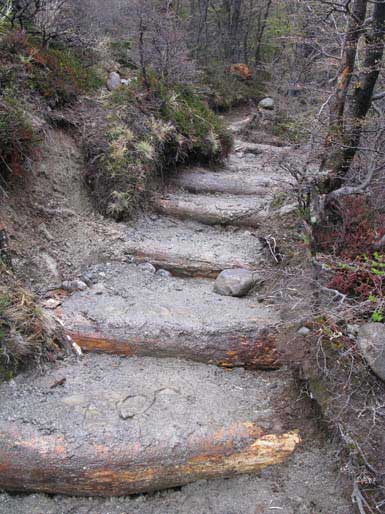 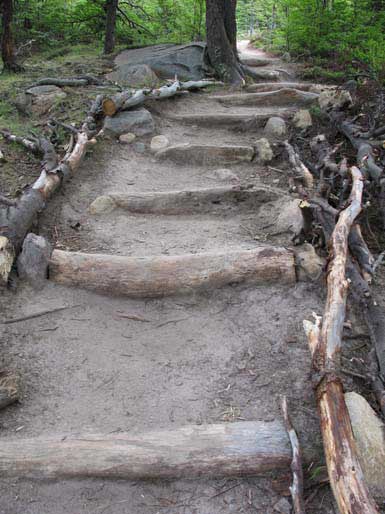
Above (both): Wood steps below the Rio Blanco camp.
Work photos:
Here are a few samples from the seven weeks of work.
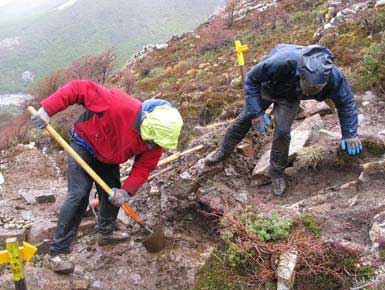 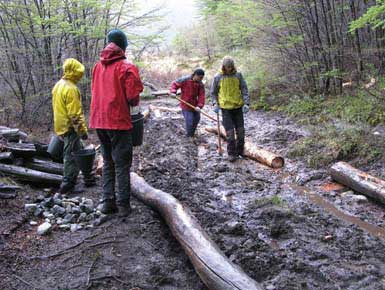
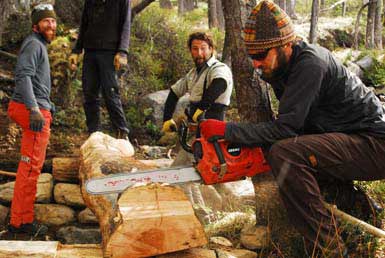 
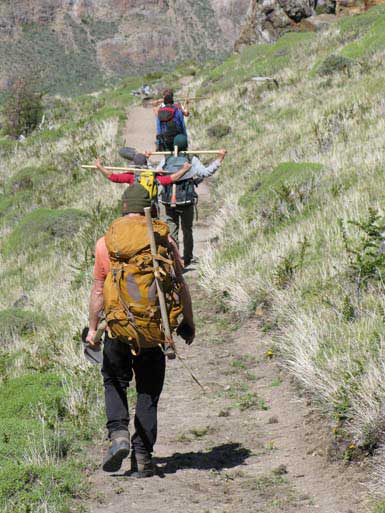 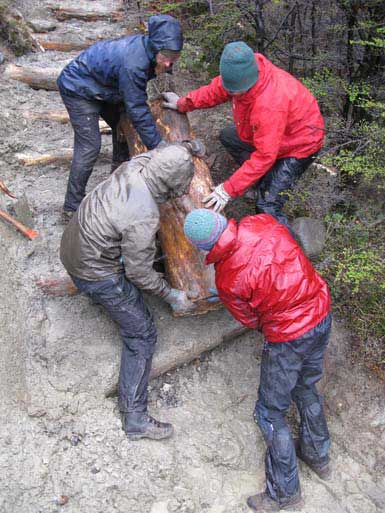
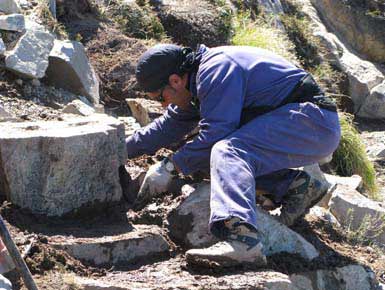
Revegetation work
Personnel.
Marcela Ferreyra, a biologist with extensive experience on high altitude ecosystems spearheaded the revegetation part of the project. Rolando Garibotti helped arrange some of the logistics, but the bulk of the actual work was done by APN (Argentine National Park Service) personnel including: Carlos Zoratti (head of Seccional Lago Viedma), Mela Irribarren, Juanjo Landucci, Aristides Aieta, Pablo, Gerardo and all the other members of the Seccional Lago Viedma, as well as the continued invaluable help of volunteer Marcos Mendoza.
Margaret Wilson a Grand Teton National park employee with close to 20 years experience on revegetation work was kind enough to provided much literature on the subject.
Plan.
The revegetation work was divided in two, an initial six days of work in February to evaluate a number of possibilities as well as to set up a number of work samples to see how well they work (this included moving certain plants as well as planting seeds of a numbers of species in a green house in town) followed by seven days of work in April which is a more suitable time of the year to move live plants, to plant seeds in the wild and other.
The main areas of focus were a re-route just below Rio Blanco camp, the area immediately around Rio Blanco camp and a short section of the re-route above the Rio Blanco camp. Because of the weather conditions in April little work could be done in the higher sections of the Laguna de los Tres trail.
In February the following species were moved to heavily eroded areas, as trials to see how well they do: Murtilla (Empetrum rubrum), Parrillita (Ribes cucullatum), Marsipospermo (Marsipospermun grandiflorum), Romerillo (Chiliotrichum diffusum), Calafate (Berberis microphylla), Erigeron (Erigeron sp.), Ñire (Nothofagus antarctica), Chapel (Escallonia virgata), Lenga (Nothofagus pumilio), Frutilla del diablo (Gunnera magellanica) and Chaura (Gaultheria mucronata).
Also in February, on several sections of closed trail the dirt was softened to speed the natural process of recovery and on several occasions plants that were threatened by being too close to the trail or on overhanging lips of the trail were move to “safer” locations.
In these outings seeds were collected for the following species: Murtilla (Empetrum rubrum), Lenga (Nothofagus pumilio) and Poa seedlings (Poa alopecurus). Most of the seed collection was thanks to Mela Iribarren and Juanjo Landucci. Later these seeds were planted in controlled environments in town, in hopes of being able to grow small plants but also to learn which is the best planting technique for each particular seed. Being able to successfully plant Empetrum Rubrum from seed would be a big help to recover the upper portions of the Laguna de los Tres trail.
Marcela Ferreyra’s complete report for the revegetation work done in February can be read here (in PDF format, in Spanish, 3.7MB). This includes details on planting techniques and other.
During the seven days of work in April the following seeds were planted in the wild: Cacho de Cabra (Osmorhiza chilensis), Nothofagus pumilio (lenga), Osmorhiza chilensis (cacho de cabra), Abrojo o Pimpinella (Acaena ovalifolia) and Murtilla (Empetrum rubrum).
In the lower reroute section work was done to soften the edges of the old –now closed trail and to fill up the eroded areas to allow for a faster natural recovery process. Also 38 large pieces with a diversity of plants were move from other areas to there. In the higher reroute section, right above the Rio Blanco camp, 34 big pieces with a diversity of plants were move from other areas to there.
The experiences of cultivation continued down in town, courtesy of the work of Mela Iribarren and Juanjo Landucci, who collected, cleaned and planted seeds for a number of species including Lenga (Nothofagus pumilio), Anémona (Anemone multifida), Abrojo (Acaena ovalifolia) and Cacho de cabra (Osmorhiza chilensis).
Marcela Ferreyra’s complete report for the revegetation work done in April can be read here (in PDF format, in Spanish, 1.8MB). This includes details on planting techniques and other.
The total revegetation work for both February and April, not including the time to collect the seeds and much of the time dedicated to plant them in town was well over 200 man hours of work.
Many thanks go to the Ricardo Sanchez and the Chalten Chamber of Commerce (Camara de Comercio), as well as to Albergue Patagonia, Posada Lunajuim and Hosteria Kaulem for providing lodging for Marcella Ferreyra.
Also a very special thanks to all the personnel from the Seccional Lago Viedma that completed the bulk of this first face of revegetation work.
Please Do Not Reprint This Article
This article is copyrighted. Please do not reprint this article in whole or part, in any form, without obtaining written permission.
|
Related articles
Project description
Work reportsReport 2008Report 2009
Revegetation reports
Revegetation 2/09 (pdf)
Revegetation 4/09 (pdf)Revegetation 12/2009 (pdf)
Acces/Acceso
Montaña de todosMontañas prohibidas |






















